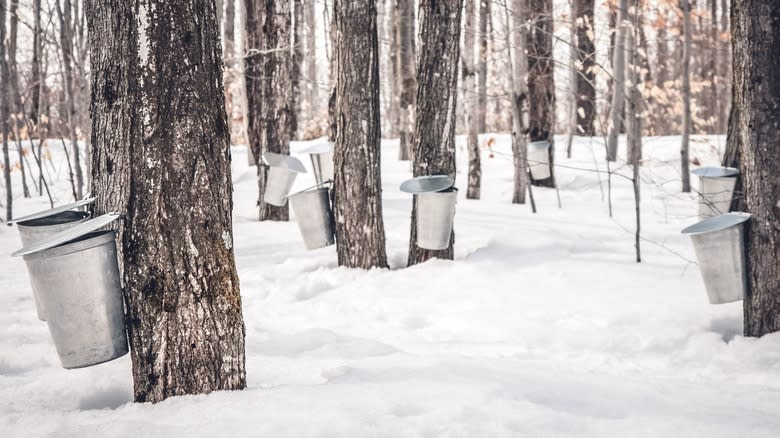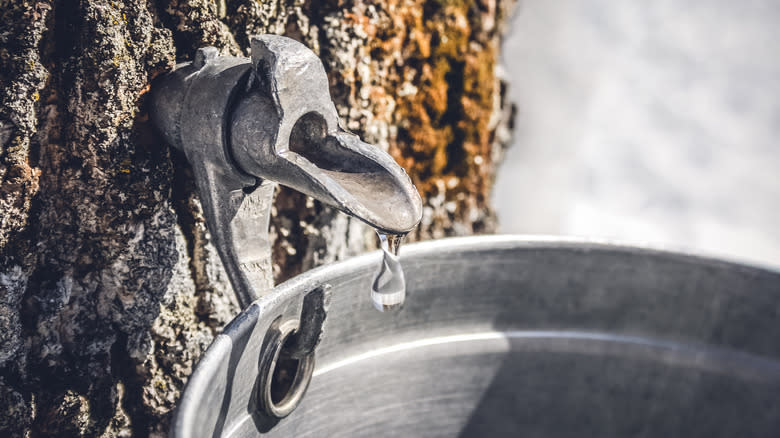Are We Going To Run Out Of Maple Syrup?

Climate change is one of the largest crises humanity is currently facing. For example, you'll want to plan your trip to the Maldives before the country literally sinks into the ocean. While not all aspects of this crisis are created equal, smaller concerns are still just as troubling. Tragically, global warming is messing up tasty maple syrup. Warmer weather makes sap less sugary, so tree tappers have to boil down the said reduced-sugar sap for longer.
As such, a smaller amount of syrup is created and it requires way more fuel to do it. Both reduced batch size and higher energy expenditure contribute to the struggling modern maple syrup industry. Also, the amount of time in which sap thaws and flows from the spigots is shortened. When sap doesn't switch between solid and liquid, there is a shorter stint where trees are tappable. Though the extinction of maple syrup isn't imminent, climate concerns could continue to wreak havoc on the syrup supply, leaving disheartened diners with stacks of plain pancakes.
Read more: 14 Liquids To Add To Scrambled Eggs (And What They Do)
The Syrup Shortage Is A Sticky Situation

Over 60% of the world's maple syrup comes from Canada. Specifically, it is shipped from one of three gargantuan warehouses in Quebec. These sizable storage spaces can contain up to 133 million pounds of sweet syrup, but today, the actual amount is under 7 million pounds -- and the past several years have seen these specific syrup levels in disarray. Some years, the syrup is plentiful, but generally, its supply is dwindling.
The year 2022 saw historic production levels, but the modern maple syrup market has exploded since the pandemic lockdowns were lifted, and the successful season was still only sufficient for satiating the market's demand, so no syrup was added to storage. The 2023 maple syrup harvest was underwhelming yet again, and the supply is currently at its lowest level in 16 years. Though 2024's syrup haul has not yet been properly assessed, the stories currently coming from syrup producers suggest that this year was in line with the troublesome downward trends.
Warmer Winters Disrupt The Maple Syrup Market

The syrup reserve in Quebec represents a sizable section of the global maple syrup supply, but maple trees everywhere have had difficulty producing. Climate change is continuing to crush the sap supply in a number of ways. For starters, the sugar maple seed itself sprouts in cold temperatures. For most of the plant's existence on Earth, this was an excellent evolutionary advantage. Today, the changing climate has turned this adaptation into a detriment, as it makes the maple seedling, which once thrived in the harsh Canadian cold, a less competitive plant.
Furthermore, sugar maple trees cannot grow in fully soaked soil, so the frequency of floods caused by climate change could prove disastrous for the tree's future. And for the maple trees that have already grown into sap-bearing specimens, climate change also proves problematic. As previously mentioned, warmer temperatures have made maple trees produce sap that has less sugar, so the end yield of syrup is smaller. During warmer winters, sap doesn't freeze solid while we sleep and thaw during the day. When it doesn't consistently change physical states, the sap season is shorter.
The climate crisis changing the maple syrup market as we know it can be alarming, but concerned scientists and growers have taken efforts to combat the issue. Sugar maple trees have long been the standard source of syrup, but farmers have begun growing red maples, which are more tolerant of the increasingly warmer conditions. Adding diversity to the maple tree population also mitigates the potential pest problem, as a single species of insect cannot affect both varieties.
Read the original article on Daily Meal

